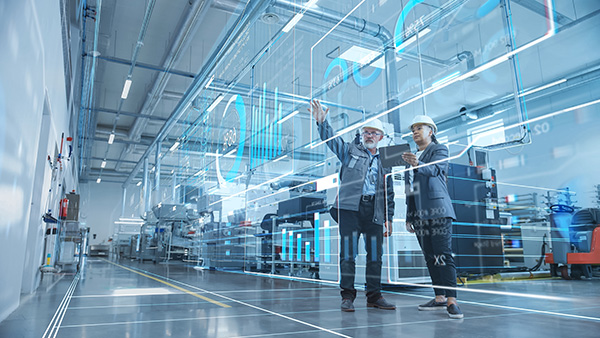Joined-up Thinking 2.0
 AI factories could be the next step for smart manufacturing.
AI factories could be the next step for smart manufacturing.
Joined-up thinking is a concept that can deliver a multitude of benefits. Where there are many differing interests to satisfy, bringing together ideas and coordinating actions in a holistic approach can lead to a better outcome for all. Not the least, it can reduce duplication of efforts and resources, making processes more streamlined and cost-effective.
In practice, joined-up thinking is often difficult to achieve. Institutional barriers, differing priorities among stakeholders, and the sheer number and diversity of variables to evaluate and manage can conspire to thwart the best intentions.
Manufacturing is a complex sequence of events that demands substantial joined-up thinking simply to make it happen and see a result coming off the production line. Increasingly, however, this is not enough in the modern world. Numerous related factors must be considered, especially the environmental impact of our activities. Smart manufacturing has enabled us to address some of these issues, connecting the factory and IT domains and bringing manufacturing data into enterprise systems to enhance planning and historical analysis for continuous improvement. This is joined-up thinking 2.0, if you like.
We now have the opportunity to take a further step forward. Arguably, we must move in this direction if we are to answer the challenges we face today, ensure sustainability and address the current geopolitical issues that are likely to reverberate for years to come. It’s time to make the leap from smart manufacturing to AI manufacturing. The power to be gained from this transition lies in extending the joined-up thinking, both backward into the supply chain as well as forward through the entire product lifecycle to disposal and recycling or reclamation of materials at the end of life.

AI can be used to optimize product design, material selection and production processes to minimize environmental impact and promote sustainability.
AI can help us achieve this through its ability to evaluate and manage many more variables than humans or the traditional smart manufacturing applications could ever consider at one time. AI can analyze vast amounts of data in real time, making data-driven decisions to optimize processes at every stage. AI can consider all aspects of the product lifecycle, from supply chain and production processes to end-of-life scenarios. This holistic view allows more comprehensive and efficient optimization. Moreover, it can predict and prevent equipment failures, reducing downtime and maintenance costs, whereas smart manufacturing systems often lack such predictive capabilities.
Moreover, AI can dynamically adjust supply-chain operations based on demand, reducing excess inventory and optimizing transportation routes. Smart manufacturing typically focuses on production processes rather than the entire supply chain. Where smart manufacturing systems tend to focus on optimizing processes individually, AI can consider the entire business strategy to optimize production cost, quality and customer demand simultaneously. And we can use AI to optimize product design, material selection and production processes to minimize environmental impact and promote sustainability.
It’s just as important that AI gives us the power to adapt more rapidly than traditional smart manufacturing systems as political and economic conditions change, new technologies emerge and customer preferences evolve.
Right now, we are in the process of a major transition as companies are moving important manufacturing activities away from China and Taiwan toward alternative destinations. Southeast Asia is among the most popular choices, and Vietnam and Thailand especially. It’s an opportunity for a fresh start that gives the chance to leverage AI extensively in designing new factories and shaping the manufacturing world to come.
It’s easy to say and complicated to achieve. New tools are emerging, however, that can enable the transition to AI manufacturing. The more sophisticated use of digital twins is one development we can see happening now. I was recently introduced to the work of Elsyca, which is bringing AI-powered innovation into electrochemical processing by creating tools that will deliver benefits all the way from product design to setting up factories, before any product design or process configuration begins. At the EIPC Summer Conference this June, a delegation from Elsyca introduced their tools for copper balancing and electroplating that can increase PCB manufacturing yield, leading to greater efficiency and reduced materials wastage as well as improving electrical performance.
Other exciting developments are in the pipe, such as the work of companies like Nvidia, with its Omniverse platform and Isaac robotics simulator. Foxconn is among the companies that have spotted the opportunities these frameworks can offer to create efficient and adaptable buildings and factories, as well as products and services. Isaac lets you simulate industrial robots, including mobile robots such as AGVs, and use modular 3-D assets to build a working environment and to study and optimize the entire system before committing to a project plan. Last month, Nvidia and Foxconn jointly announced their vision for an AI-powered future encompassing activities from building EVs to setting up AI factories using simulation to optimize workflows and operational efficiency and ensure high production and quality standards can be met before committing to deployment in the physical world.
An approach like this can quickly evolve into a framework that lets companies build and scale manufacturing and configure supply chains to leverage an established template. They can also design and build new factories quickly and so adapt to changing economic pressures and political and market demands.
It’s yet another exciting prospect that AI can offer us as we continue to work out its full power and ability to help us meet our needs. The joined-up thinking we often wish for, in everything from planning services to managing transport infrastructures and distributing energy, could soon become far more pervasive and far-reaching than we ever imagined.
is technology ambassador at Ventec International Group (ventec-group.com); alun.morgan@ventec-europe.com.







